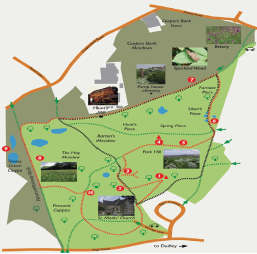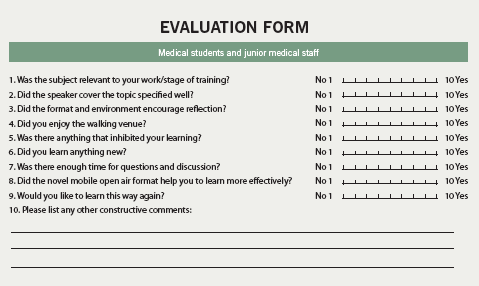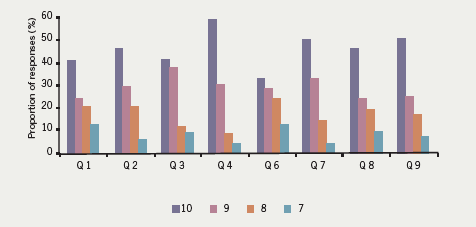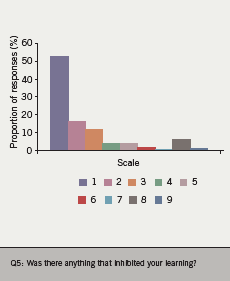Coronary heart disease is a leading cause of mortality and morbidity worldwide. Risk factor modification through a robust cardiac rehabilitation programme is rewarding and accounts for the major decline in mortality due to coronary heart disease in the long term,1 thus, making it an essential part of the curriculum. With this in mind, we conducted an observational study based on the feedback of 114 medical students over a four-year period about exercise tutorial in cardiac rehabilitation. Data were collected on a 10-point scale questionnaire. An overwhelming majority of students (more than 90%) were deeply impressed by this novel approach of being taught about cardiac rehabilitation. They strongly recommended this unique approach, as not only an effective tutorial on cardiac rehabilitation, but also advocated it enthusiastically as a general teaching method.
Introduction
Coronary heart disease is a common killer and accounts for approximately 105,000 deaths per year in the UK. Recent research has shown that the most effective strategy, despite the advances in interventional cardiology, is effective secondary prevention and risk factor modification along with a robust rehabilitation programme to improve lifestyle, especially for those who have experienced a coronary event.2 It is also the most cost-effective way of reducing cardiovascular mortality and morbidity. Salvaging the acutely ischaemic myocardium with catheter-based interventions without addressing the underlying pathophysiological process represents sub-optimal care.3
Our sedentary modern lifestyle, leading to the obesity epidemic, is a huge challenge. Lifestyle modification including regular physical activity is one of the cardinal components of cardiac rehabilitation.4
“Cardiac rehabilitation is a process by which patients with cardiac disease, in partnership with a team of health professionals, are encouraged and supported to achieve and maintain optimal physical activity and psychosocial health.”5
The aim of this study is to emphasise the importance of cardiac rehabilitation in the curriculum, as well as promote a novel way of conveying it. Below, we analyse the impact of an exercise tutorial about cardiac rehabilitation and consider whether this will be an effective way of teaching as a whole.
Study design

This was an observational study conducted between June 2005 and March 2009, involving the learning experience of third-, fourth- and fifth-year medical students who were taught about cardiac rehabilitation over a two-mile exercise route. Each study group involved two to seven students. The tutorial was primarily designed for the year 4 cardio-renal-urology (CRU) module; therefore, the majority of participants in this study were from the same year. The total number of students taking part in this study and exercise feedback was 114, of whom the various proportions from corresponding years were 29 from year 3, 80 from year 4, and five students from year 5.
The teaching tutorial on cardiac rehabilitation took place over a two-mile walking distance called the Action Heart ‘Walking for Life’ route, which is around the Barrow Hill Nature Reserve in Dudley, adjacent to Russells Hall Hospital (figure 1).
Data collection
Data were collected using a 10-point scale questionnaire (figure 2). Data obtained from the questionnaire of 114 medical students was analysed in a systematic way.

Results

An overwhelming majority of students enjoyed this unique way of being taught about cardiac rehabilitation as an exercise tutorial and highly recommended this novel method of teaching as a whole. Full marks (10/10) were awarded by 46% of respondents, while almost 90% of total responses were graded as 8/10 or above (figure 3). Only seven students (6%) graded the issue of wind blowing impeding proper hearing on windy days as significant (7/10), while the majority of students opined that walking in an open environment helped them concentrate better. It is worthwhile mentioning that question No. 5 looking at this particular aspect of exercise tutorial was graded oppositely to the other questions with 1/10 in fact meaning no disturbance and 10/10 indicating extreme hindrance by wind (figure 4).

The students found this opportunity exceptionally unique, entertaining, informative and a superb way of being taught about cardiac rehabilitation, and they unanimously advocated this as a teaching method for other topics.
Some of the positive remarks given by medical students were:
- “Was good to learn in a different environment and get fresh air. Much more enjoyable than normal lectures!”
- “Recommend it to other hospitals.”
- “Was a brilliant teaching session and was nice to learn in a different environment, made it easier to concentrate for some reason!”
- “Lovely way to learn, easier to concentrate and take in information.”
- “Liked the idea of going on a walk, aided concentration and made a change.”
- “Very mind stimulating – a novel experience.”
Conclusion
This report represents a unique study of its kind in terms of analysing exercise tutorial as a unique teaching method and also emphasising cardiac rehabilitation as an essential part of the curriculum. The study had a decent sample size and was conducted over a considerable length of time. The exceptionally positive response of a large number of medical students authenticates its findings, and suggests it could be an extremely effective way of teaching any topic. This study does not negate the need for classrooms and lecture theatres; however, it introduces a novel idea of teaching topics in small groups as exercise tutorials, which can be equally enjoyable and informative.
Conflict of interest
None declared.
Key messages
- Cardiac rehabilitation is an essential component of coronary heart disease prevention
- Teaching cardiac rehabilitation in an exercise tutorial is a unique teaching method, which was well received with students
- This teaching method could be applied to other topics
References
1. Unal B, Critchley JA, Capewell S. Explaining the decline in coronary heart disease mortality in England and Wales between 1981 and 2000. Circulation 2004;109:1101–07.
2. Taylor R, Brown A, Ebrahim S et al. Exercise-based rehabilitation for patients with coronary heart disease: systematic review and meta-analysis of randomized controlled trials. Am J Med 2004;116:682–92.
3. Harbman P. Review: secondary prevention programmes with and without exercise reduced all cause mortality and recurrent myocardial infarction. Evid Based Nurs 2006;9:77.
4. Smith D. Review: increased physical activity and combined dietary changes reduce mortality in coronary artery disease. ACP J Club 2006;144:16.
5. Jolliffe JA, Rees K, Taylor RS, Thompson D, Oldridge N, Ebrahim S. Exercise-based rehabilitation for coronary heart disease. Cochrane Database Syst Rev 001;(1):CD001800.
